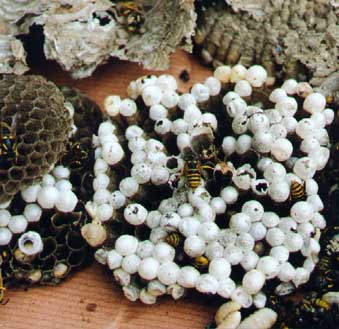How the Wasp was Done
Terence Mc Geary
terrymcgeary@hotmail.com
Freelance writer/photographer
108 Carnegie Hill
East Kilbride, Scotland, UK
G75 0AE
Phone UK(44) 0777 310 9819

Confession they say is good for the soul.
Okay, here goes: I am a mass murderer, guilty of multiple counts of deliberate, premeditated insecticide.
Can I, a fully paid up member of the Institute of Biology as well as a nature lover, justify my application of deadly nerve poison to a social colony of 250 female inhabitants and their juvenile offspring?
Well probably, at least to my own biased satisfaction if not to paid up members of WWF or Greenpeace. The colony of Vespa vulgaris or common wasps that had triggered my insecticidal tendencies recently claimed a new wooden bird box in my back garden. Instead of playing host or landlord to a delightful pair of blue-tits and their handful of adoring cutsie offspring in my custom made, aluminium roofed des-res (desirable residence), I had the horror of a few hundred yellow-black demons busily making alterations without any planning permission whatsoever.
As grey external wall paper was added daily to the green painted frontage the aerial traffic back and forth increased apace, the arthropod equivalent of London airport during holiday season, adding an 'interesting' natural history dimension to the BBQ.
A visit to a few web sites for insider info confirmed my worst fears: these 'yellow jackets' as they are sometimes known, were increasing in number inside as fast as the wallpaper was added to the outside. The queen had arrived first after a winter doze, laid a few eggs to set herself up with a set of female helpers, then continued laying dozens, each into a separate cell and all appearing after a couple of weeks as yet more worker females. Later on queens and males would be produced, the good news for the boys being they get to mate, the bad news is they don't get to snuggle up with their girlfriends and die in the winter.
I have some sympathy and admiration for wasps, I truly do. The non-union worker females bust a gut on gruelling 17 hour day flying missions gathering various insects - many of which are plant parasites - for the high protein diet needed by the larvae, and making paper from plant material such as dead weed stalks. The stings aren't mainly for our benefit but to subdue any large prey reluctant to become baby food.
One quiet afternoon I managed to locate a scraping sound which turned out to be a wasp's massive jaws dismantling the surface of a dried weed stem for paper. So they are not all bad most of the time since they help clean up our plants: biological control you for no outlay. But despite their useful position in the loftier parts of the food pyramid, for social insects they do develop some pretty anti-social habits.
When the larvae have upped and left home the workers have no need for catching insects and are at a loose end. These unemployed ladies tend to drown their sorrows in candy - or at least sugar in its many forms. They head for the ripe fruit, the jam sandwiches, the pop and the ice cream. When man and insects come into close proximity something's gotta give. A rolled up copy of your favourite tabloid newspaper can work wonders in a skilled hand.
As a lecturer I know the panic that can be induced by a single wasp flying into a class. Some students will exit at speed to avoid any chance of being injected by the 0.01mg of toxin (only a tenth the quantity of a bee sting incidentally, but wasps can give you multiple jags!). Horrific traffic accidents have been due to pedestrians making a sharp exit from swarms straight into the road.
And of course some people have good reason to give these insects stings a wide berth: those with severe allergy may develop sometimes fatal anaphylactic shock instantly on being stung.
So despite knowing the ecological benefits of wasps, and totally ignoring the altruistic natures of the worker sisterhood I decided they had to die. Every one, females and young.
This course of action is not something to embark upon lightly, if at all. And I would definitely leave it to a professional if I had an allergy to venom. But being too mean to fork out the fee, and taking the stupid 'man's gotta do' attitude, I had a go.
Armed with information gleaned from the PC I bided my time. I struck at dead of night, attired like a hybrid between the Lone Ranger and a Middle-eastern terrorist, with goggles, gloves, tight hood and bandana over the mouth. No bare skin, no open sleeves or trouser legs. And trainers for a quick getaway just in case! Wasps, I am informed, fly at around 7mph so we ought to outrun them if push comes to shove.
At this point, I could probably produce brochures on wasp removal, but I would rather use my time to plant more vegetables in my garden. A simple search on the internet can get you all the information you need anyway.
Red torch in hand (they can't see red light apparently) I made several sorties up my ladder. Even approaching midnight a few workers were carrying out some quality control on the front porch.
Gentle puffs of bendiocarb with the squeezy bottle sent all but one stoic individual indoors. A few massive doses into the entrance hole followed by a sponge bung and the mass assassination was complete.
Almost complete: a few forlorn stop-outs returning home the following morning after a night out on the tiles buzzed around unable to comprehend the disaster that had befallen their sisters and queen. Life's a bitch.
So that's my confession. Guilty as charged. Remorse? No way.
Would I do it again?
You bet. Wasps are fine but not in my back yard your honour!

![[new]](new01.gif)
